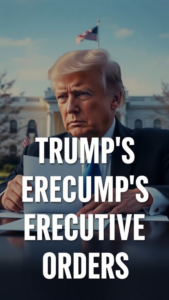The Immediate and Long-Term Effects of Trump’s Executive Orders on U.S. Policy
When examining the impact of executive orders issued during Donald Trump’s presidency, it’s clear that they left a significant mark on U.S. policy. These directives, often used to bypass congressional gridlock, shaped both immediate and long-term outcomes across various sectors. From immigration to trade, healthcare to environmental regulations, the effects of these orders continue to influence the nation.
Immigration Policies and Their Ripple Effects
One of the most notable areas impacted by Trump’s executive orders was immigration. Policies like the travel ban targeting predominantly Muslim countries sparked immediate controversy and legal challenges. While the ban was eventually upheld by the Supreme Court, its implementation created a wave of uncertainty for travelers, immigrants, and businesses relying on international talent.
In the long term, these orders reshaped the conversation around immigration reform. They highlighted the executive branch’s power to enforce stricter border controls and prioritize national security over humanitarian concerns. This shift has influenced subsequent administrations, forcing them to address the balance between security and inclusivity.
Trade and Economic Policies
Trump’s executive orders on trade, particularly those targeting China, had immediate economic consequences. Tariffs on Chinese goods led to increased costs for American consumers and businesses. While some industries, like steel and aluminum, saw short-term benefits, others faced challenges due to retaliatory measures from trading partners.
Over time, these policies reshaped global trade dynamics. They pushed companies to diversify supply chains and reconsider their reliance on Chinese manufacturing. The long-term effects include a more fragmented global trade system and a renewed focus on domestic production, which continues to influence U.S. economic strategies.
Key Trade-Related Executive Orders:
- Imposing tariffs on steel and aluminum imports.
- Withdrawing from the Trans-Pacific Partnership (TPP).
- Re-negotiating NAFTA, resulting in the USMCA agreement.
Healthcare and the Affordable Care Act
Trump’s executive orders targeting the Affordable Care Act (ACA) had immediate effects on healthcare accessibility. By reducing funding for outreach programs and expanding short-term health plans, these orders weakened the ACA’s reach. Many Americans faced higher premiums and fewer coverage options as a result.
In the long term, these actions have fueled ongoing debates about healthcare reform. They underscored the need for a more stable and comprehensive system, influencing discussions around universal healthcare and public options. The ripple effects of these orders are still felt as policymakers grapple with how to address healthcare affordability and accessibility.
Environmental Regulations and Climate Change
Executive orders aimed at rolling back environmental regulations had immediate consequences for industries like energy and manufacturing. By loosening restrictions on emissions and fossil fuel production, these policies boosted certain sectors but raised concerns about environmental degradation.
Over time, these actions have had a lasting impact on U.S. climate policy. They delayed progress on renewable energy initiatives and international climate agreements, such as the Paris Accord. The long-term effects include a more polarized debate on climate change and a renewed push for sustainable practices in both the public and private sectors.
Environmental Policies Impacted:
- Withdrawal from the Paris Climate Agreement.
- Rollback of the Clean Power Plan.
- Expansion of offshore drilling opportunities.
Labor and Workplace Regulations
Trump’s executive orders also targeted labor and workplace regulations, with immediate effects on workers’ rights and protections. Policies like reducing overtime pay eligibility and limiting union organizing efforts shifted the balance of power in favor of employers.
In the long term, these changes have influenced the labor market and worker advocacy. They have sparked a renewed focus on fair wages, workplace safety, and the role of unions in protecting employee rights. The ongoing debate around these issues reflects the lasting impact of these executive orders.
Foreign Policy and National Security
Executive orders related to foreign policy and national security had immediate effects on U.S. relationships with other nations. Actions like withdrawing from the Iran nuclear deal and recognizing Jerusalem as Israel’s capital reshaped diplomatic ties and global perceptions of U.S. leadership.
Over time, these decisions have influenced the trajectory of U.S. foreign policy. They have prompted discussions about America’s role in global affairs and the importance of multilateral agreements. The long-term effects include a more unpredictable international landscape and a reevaluation of U.S. alliances.
The executive orders issued during Trump’s presidency had profound and lasting effects on U.S. policy. From immigration to trade, healthcare to the environment, these directives continue to shape the nation’s trajectory. Understanding their impact is crucial for navigating the challenges and opportunities they present in the years to come.
Comparing Trump’s Executive Orders to Those of Previous Presidents: A Historical Perspective
When examining the executive orders issued by Donald Trump during his presidency, it’s important to place them in a broader historical context. Comparing his actions to those of previous presidents reveals both unique approaches and recurring patterns in how executive power has been used over time.
Executive orders have long been a tool for presidents to implement policy without congressional approval. Trump’s use of this power was notable for its frequency and focus on key issues like immigration, trade, and deregulation. For example, his travel ban targeting several Muslim-majority countries sparked significant debate and legal challenges. This approach mirrored past presidents who used executive orders to address urgent national concerns, but the scope and tone of Trump’s orders often stood out.
Historically, presidents like Franklin D. Roosevelt and Harry Truman relied heavily on executive orders to navigate crises. Roosevelt issued over 3,700 orders during his presidency, many of which were tied to the New Deal and World War II. Truman’s desegregation of the military through Executive Order 9981 was a landmark moment in civil rights. In contrast, Trump’s orders were more focused on reversing policies from the Obama administration, such as rolling back environmental regulations and withdrawing from international agreements like the Paris Climate Accord.
One key difference lies in the intent behind these orders. While past presidents often used executive orders to address immediate national challenges, Trump’s orders frequently aimed to fulfill campaign promises. For instance, his orders on border security and immigration enforcement were central to his 2016 campaign platform. This approach reflects a broader trend in modern politics, where executive actions are increasingly tied to partisan agendas.
Another area of comparison is the legal and public response to these orders. Trump’s travel ban faced immediate backlash and was eventually upheld by the Supreme Court after multiple revisions. Similarly, past presidents have seen their executive orders challenged in court. For example, Truman’s attempt to seize steel mills during the Korean War was struck down by the Supreme Court in Youngstown Sheet & Tube Co. v. Sawyer. These cases highlight the ongoing tension between executive authority and judicial oversight.
Here’s a closer look at how Trump’s executive orders compare to those of his predecessors:
- Immigration: Trump’s orders on immigration, such as the travel ban and the termination of DACA, were among his most controversial. In contrast, Obama used executive orders to protect Dreamers, while Reagan’s 1986 Immigration Reform and Control Act focused on broader reforms.
- Trade: Trump’s emphasis on renegotiating trade deals, like NAFTA, through executive actions was a departure from past presidents who often relied on congressional approval for major trade agreements.
- Environment: Trump’s rollback of environmental regulations contrasted sharply with Obama’s use of executive orders to promote clean energy and combat climate change.
Public perception also plays a role in how executive orders are received. Trump’s orders often polarized opinion, with supporters praising his efforts to fulfill campaign promises and critics accusing him of overreach. This dynamic is not new; past presidents like Lincoln and Wilson faced similar divisions when using executive orders during times of war and crisis.
It’s also worth noting the long-term impact of these orders. While some of Trump’s actions, like the travel ban, have had lasting effects, others have been reversed by subsequent administrations. This pattern of reversal is common in U.S. history, as new presidents often undo the executive orders of their predecessors. For example, Biden reversed many of Trump’s orders on climate change and immigration shortly after taking office.
In analyzing Trump’s executive orders, it’s clear that while his approach was distinct in many ways, it also fits within a broader historical framework. Presidents have long used executive orders to shape policy, respond to crises, and advance their agendas. What sets Trump apart is the extent to which his orders were tied to his political brand and the intensity of the reactions they provoked.
Understanding this historical perspective helps us see how executive orders have evolved over time. They remain a powerful tool for presidents, but their use and impact are shaped by the political and social context of the moment. By comparing Trump’s actions to those of past presidents, we gain a deeper appreciation for the complexities of executive power and its role in American governance.
Conclusion
Donald Trump’s executive orders left a significant mark on U.S. policy, shaping both immediate outcomes and long-term trajectories. From immigration reforms to economic policies, these orders sparked debates, legal challenges, and shifts in governance. While some measures delivered quick results, others faced delays or reversals, highlighting the complexities of executive power. Over time, their impact continues to influence political discourse and policy-making, underscoring the lasting ripple effects of presidential decisions.
When compared to executive actions by previous presidents, Trump’s approach stands out for its boldness and frequency. Unlike predecessors who often used executive orders sparingly, Trump relied heavily on them to bypass legislative gridlock. This strategy drew comparisons to leaders like Franklin D. Roosevelt and Barack Obama, who also wielded executive power to address pressing issues. However, Trump’s orders often leaned more toward deregulation and unilateral action, reflecting his administration’s distinct priorities.
Analyzing Trump’s executive orders reveals a presidency defined by decisive action and controversy. Whether praised or criticized, these orders reshaped policies and set precedents for future administrations. As history unfolds, their full impact will remain a topic of discussion, offering lessons on the balance of power and the role of executive authority in shaping the nation’s direction.




